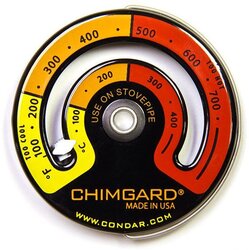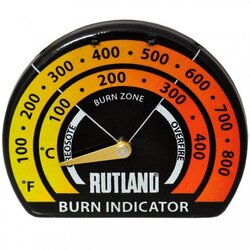First I'll tell you that the stove is a Drolet Escape 1800 freestander and I have been having great luck with getting fires started and then getting the Secondarys to fire off. Actually the stove seems to be idiot proof and has been very controllable using the damper. I havent got it rip roaring yet with a full load but next weeks weather will probably allow me to do that. My question is related to the construction of the stove and how it might affect the temp reading of my thermometer. The stove has a shroud (on the top surface)that extends from the back of the stove to in front of the stovepipe connector by about three inches. The instructions for the thermometer say to place it 18 inches above the stove top. When I place it there I really have to let the fire inside my stove roar wide open to get the reading to 350 degrees and it seems to use most of the fuel to get there. If I place the guage on the stove top I'm running around 475 to 500 degrees. So my question is do you think that the shroud is acting like a clearance reduction thing much like a sheet of steel on your walls 1 inch from the wall surface. When I place the guage around 10-11 inches I easily get to the 350-425 degree range after 7-12 minutes and then shut down primary air and all is good? What to think ?
Stack temp gauge placement on Drolet escape 1800?
- Thread starter Mark Richards
- Start date
-
Active since 1995, Hearth.com is THE place on the internet for free information and advice about wood stoves, pellet stoves and other energy saving equipment.
We strive to provide opinions, articles, discussions and history related to Hearth Products and in a more general sense, energy issues.
We promote the EFFICIENT, RESPONSIBLE, CLEAN and SAFE use of all fuels, whether renewable or fossil.



